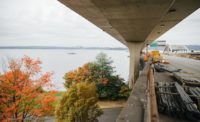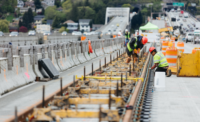Seattle-Area Rail Crosses Freeways, Floating Bridges

Crews install overhanging brackets on concrete girders that serve as a foundation for the East Link aerial guideway in South Bellevue.
PHOTOS COURTESY OF CENTRAL PUGET SOUND REGIONAL TRANSIT AUTHORITY

The South Bellevue rail station will include a 1,500-vehicle parking garage.

Laying track on the Homer M. Hadley Memorial Bridge required years of extensive testing. It is the first time light rail has been placed on a floating bridge.

The Mercer Island Station was one of 10 stations built in a project that included a tunnel, below-grade track and an elevated guideway, not to mention two interstate-highway crossings.

Sound Transit’s Eastlink Light Rail project flows through the Seattle metro area.





Washington’s Central Puget Sound Regional Transit Authority’s $3.7-billion, 14-mile East Link extension through Bellevue offers a lesson in diversity. Not only does the 10-station light rail link from Seattle to Redmond include three different contract types out of seven major contracts, but East Link also features two interstate highway crossings, a tunnel and the world’s first light rail built on a floating bridge.
“Most people jump right to our work on the floating bridge,” says Sound Transit’s Mike Bell, senior executive project director. “It is the only place in the world where light rail is on a floating bridge, and there’s lots of engineering and research behind that design. For me, the most interesting thing about this project is the diversity of the work.”
Sound Transit is entering the fourth year of East Link’s five-year effort. With the entire project roughly 75% done and all 14 miles formed, work is restarting after a one-month stop-work order due to COVID-19.
Ridership is expected to begin in 2023, but contractors expect pandemic delays, supply-chain issues, specialty trades uncertainty and labor availability to eliminate any possible completion ahead of the nine-month float in the schedule.
Diversity of Work
Sound Transit is placing light rail on one of the world’s longest floating bridges, the one-mile Homer M. Hadley Memorial Bridge that carries westbound traffic for Interstate 90.
“The engineering lasts a lot longer than the construction,” Bell says. It took experts from across the world nearly a decade to design a rail line on a floating structure. After the mock-ups were designed and tested at a rail yard in Colorado, Sound Transit deployed them on I-90. The first step—and one of the first major milestones—was placing the bridge pontoons and reinforcing the concrete with a steel framework to allow for the extra weight of rails and trains.
Brawn Lausen, project manager for Kiewit, says the key is to stay nimble, whether it’s dealing with the geometry of a bridge originally designed for vehicles or installing the 3,600-ft-long steel strand tendons within the bridge’s concrete pontoons, which includes coring through internal diaphragms and adding 150 tons of reaction frame steel.
“This work was all in the blind, since each section of the pontoon is divided into small cells with access doors similar to the size of submarine doors,” he says.
Transitioning rail to a nearly one-mile-long floating bridge that is constantly bobbing and swaying in the water required a first-ever solution for Sound Transit. The issue centered on how crews could install rails on a bridge that uses accordion joints. The track needs to transition from a fixed structure to a floating structure that, due to water levels, rises and drops as much as 2 ft.
The three-year, $53-million design process solved the issue, with insight from British consulting engineer Andy Foan and a University of Washington study. Extensive on-ground testing in Pueblo, Colo., ensured that Foan’s solution of a curved transition element would actually work.
The design features 43-ft-long curved platforms that sit on double-pendulum bearings, allowing the rail to act like a continuously variable-radius track panel. Atop the bearings, a curved-wing element connects to a hinge that allows the rail to stay on plane, even as the lake tilts the bridge or moves it horizontally or vertically. Movement pushes on the hinge, and the bearings self-level the rail, keeping it in continuous alignment.
“It was so simple and so obvious, and when everyone saw it, they got it,” says John Sleavin, Sound Transit executive technical adviser and a project lead engineer. “It became very obvious that it would work. Andy had this great concept, and it took a team to look at every stress and strain. It was a lot of fun.”
Foan says his role was simply to help the design team “assimilate the concept and to participate in whatever way added value.”
With the design and the pontoon-reinforcing in place, Lausen says the project’s special nature makes it unlike any other heavy civil project he’s ever done. He likens it to loading and unloading a cargo vessel.
“Once we were satisfied with the modeling results, we carefully weighed and tracked each item that we put on the bridge daily so we were staying within our modeling criteria,” he says. “To put this into perspective, that required us to confirm the weights of all materials and equipment down to the bolts used in each track element every day.”
Another East Link success came in Bellevue, where underground contractor Atkinson Construction used sequential excavation to build the tunnel in one area and a retain cut in another. The 2,000-ft-long tunnel was short enough that a tunnel-boring machine wasn’t needed.
Crews completed the excavation in 15 months, five months ahead of schedule. Construction featured conventional equipment, including use of track-mounted excavators and cutters, removing soil in small batches and supporting excavated areas with spray-applied concrete.
While the tunnel project was completed largely without unexpected challenges, the retain cut in South Bellevue brought geotechnical issues in the form of soft organic matter near Mercer Slough, a swamp-like park. Working adjacent to water, Bell says the team faced “pretty significant soil challenges” that were mitigated with heavy excavation and an additional retaining wall. Crews used deep cement-soil mixing and also created stone columns to add more structure to the poor soils.
The retain cut helped to meet community stakeholder desires that the train not be elevated or even at grade. Instead, Sound Transit cut into a sloped embankment near an existing roadway and installed a pad for the train to run below the roadway grade.
East Link also crosses both I-90 and I-405, two major interstate arterials in the Seattle area. “Those are relatively small pieces in a 14-mile-long project but very big challenging pieces of work,” Bell says.
Both crossings were originally devised as cast-in-place segmental projects, but the I-405 project was actually changed to a more traditional approach at the behest of the contractor. Instead of building segmentally, the team opted for falsework and a more traditional bridge. The change yielded cost savings and optimized equipment usage.
“During the design phase we didn’t think that would work, but they were able to find a way to make it work,” Bell says.
However, on I-90, the light rail crossing required an angle and placed the crossing over the roadway for a much longer span, adding a curve, which made segmental bridge construction method the only feasible option. While not an uncommon construction method, it is still relatively unused in the Pacific Northwest.
“It is unusual when people see it,” Bell says. Starting with the center pier and working out, a pair at a time in each direction, the cantilevered approach worked well.
Kurt Kniffin, regional manager for Stacy and Witbeck, says the trickiest part of their portion of the project was dealing with four other East Link contracts at once, including having the tunnel—built on a separate contract—run through their project and tying into other civil contracts at each end of the alignment.
“The nature of working with so many other contracts and trying to align our schedules and project goals is a constant challenge,” he says.
The spread of COVID-19 has added “significant inefficiency to the already challenging task of coordination with the other contracts,” Kniffin says. The firm has adopted remote communication strategies for safety meetings, training sessions or inter-contract coordination.
Diversity of Contracts
For the seven major contracts, Sound Transit selected three different types of contract delivery—design-bid-build, CM/GC and design-build—each serving a specific purpose.
Sound Transit selected design-bid-build in portions where the agency was locked in on an early design. “While the contractor may have a great idea, we have made commitments we have to follow through,” Bell says. “We just needed someone to execute our design. The design-bid-build contract was used three times in more highly populated areas with intense community input.”
Where Sound Transit looked to advance design with contractor participation, they chose CM/GC, Washington’s version of construction management at-risk, which allows Sound Transit to work with contractors before design completion. This worked well, Bell says, on the floating bridge portion, where Kiewit, which worked with Hoffman, brought a strong team with experience and an optimized design. East Link also employed a CM/GC project with Stacy and Witbeck/Atkinson on the Bellevue portion.
In Redmond, the agency chose design-build for the project’s final two miles for design flexibility as Sound Transit worked in the Washington State Dept. of Transportation right-of-way.
“We thought it would be good to see if design-build would maybe yield some positive results,” Bell says. And it did. That project’s signature feature was a transit solution at the Overlake Transit Center, originally envisioned as a parking garage separated from a bus loop. The contractor, the Kiewit-Hoffman joint venture, proposed bringing transit to the parking garage’s first level, which further opened up possibilities for transit-orientated development.
The diversity of contracts also allowed Shimmick to earn its first Sound Transit project, working in a joint venture with Parsons, and Max J. Kuney, a local company without transit experience, to get its foot in the door.
“In my opinion,” Bell says, “having a blend of delivery methods really benefits owners as well as contractors.”










